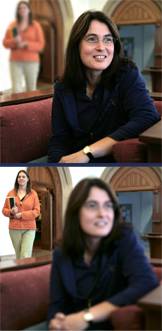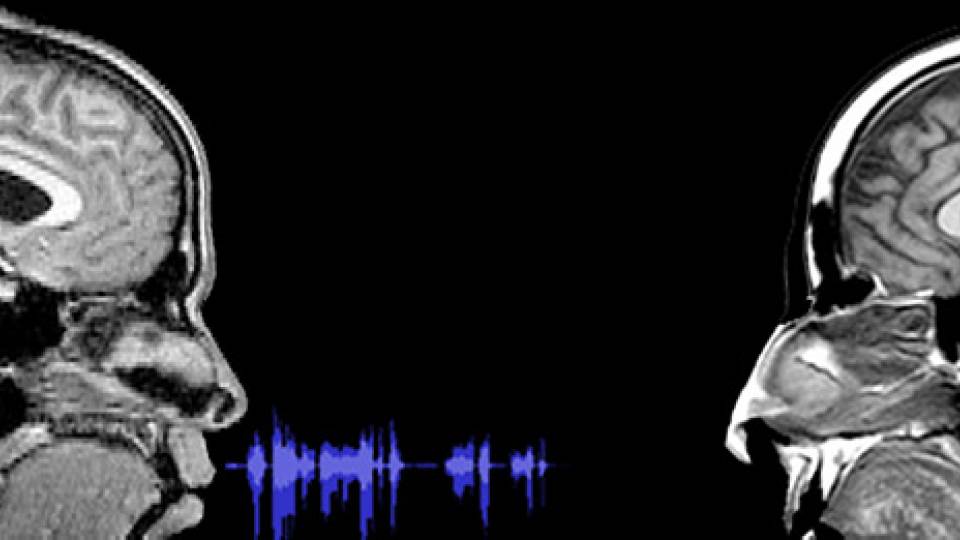Sabine Kastner likes to show people that the difference between Darth Vader and Yoda is largely a matter of perception.
"Put these glasses on," she says, offering a pair of goggles with two different-colored lenses, "then look at the screen and tell me what you see."
A glance at her laptop reveals the visage of Vader, the dark-helmeted nemesis of Jedi Knights from the "Star Wars" films, on the screen.
But tell her so, and Kastner then asks, "Are you sure you don't see anything else?"
As though succumbing to a Jedi mind trick, the viewer's brain suddenly morphs Vader's helmet into the wizened face of the elfin creature Yoda -- an image that was always there, but only visible to the left eye. Vader, drawn with a different color that penetrates the goggles' right lens, was the image the brain initially "chose" to see, the one that won out in the conflict for perception and awareness that goes on constantly within the mind. Out of this perpetual conflict, the brain builds a world from the information the eye provides.
"Visual perception is not a passive thing where you just open your eyes and take everything in. It's a creative process," said Kastner, an associate professor of psychology who specializes in neuroscience. "Moment by moment, our brains are actively constructing what we see, and I'm interested in the neural processes that underlie this creativity."
The internal battle for perceptual dominance is not necessarily violent, and it is certainly useful; the ability to focus on one subject while neglecting others is what, for example, allows people to pick out a friend in a crowd -- most people, anyway. When the mind is too aware of everything it sees, its attention is drawn everywhere at once, and the condition now called attention-deficit hyperactivity disorder (ADHD) often is diagnosed.
Kastner, who is a medical doctor as well as a research scientist, hopes that relatively simple experiments like the Vader-Yoda test can offer a window into the mind's workings that might one day lead to a treatment for ADHD and other cognitive problems. She also hopes they will prove the initial steps toward answering questions that have piqued philosophers' curiosity for millennia: What is self-awareness, and how does the mind accomplish it?
"The hope is, once we understand relatively straightforward problems like the perception of Vader and Yoda, we could then apply that understanding to much more complex concepts like self-awareness," she said. "The human species seems to be one of the only ones that is aware of itself. It is a very big question, and we're just laying the groundwork toward solving it. But I'm a dreamer, otherwise I wouldn't be a scientist."
A new approach to old questions
About two decades ago, Kastner was majoring in philosophy at Georg-August-University in Göttingen, Germany. Her interest in self-awareness attracted her to studying the brain as a physical system, and she credits a visionary neuroscientist for sending her down her path that eventually led her to Princeton.
"My mentor, Otto Creutzfeldt, was one of the first neuroscientists ever to think these philosophical questions could be addressed with neuroscience," she said. "He said I could probably pursue a doctorate in neuroscience while still in the philosophy department. But in the mid-'80s in Germany that kind of interdisciplinary work was unthinkable. People were very much tied to their fields."
Kastner followed her muse, earning both her M.D. and her Ph.D. in neurobiology from the universities of Dusseldorf and Göttingen, respectively, and becoming one of neuroscience's first generation of interdisciplinary researchers.
"I came very early on to this idea that if we bring different disciplines together we can make progress," she said. "Now, of course, we have lots of people doing it."
The main reason the tide has shifted within her field was the invention of functional magnetic resonance imaging, or fMRI, which allows a scientist to observe small-scale changes in the brain in real time while the person under observation is thinking. Kastner, who is the scientific director of the neuroimaging facility at the Center for the Study of the Brain, Mind and Behavior, came to Princeton in 2000 to develop the University's human fMRI project.
"Jon had a vision," she said, speaking of center director Jonathan Cohen, who was instrumental in obtaining the brain imaging facility, at the time the only one in the country outside a hospital setting. "It could have failed miserably, but I liked the idea of a challenge. I wanted to help build up a place."
While adding to the number of neuroscientists on the faculty, Kastner also became head of the University's Neuroscience of Perception and Attention Laboratory, where she continued her forays into the nature of awareness. Exploring how the brain responds to visual stimulation was a natural path to follow.
"Whatever self-awareness is, it's bound up with visual awareness," she said. "I'm fascinated with vision because it occupies a third of our brains' processing power."
An eye on the problem
Humans might not have evolved such big brains if they hadn't had eyes that stimulated them constantly with such overwhelming amounts of information, Kastner said. Her own fMRI research has shown that whenever visual information is coming in, multiple regions of the brain light up, revealing that a whole network of interrelated processors is required to make sense of the world.
"You can't think of the brain in a compartmental way," she said. "Nearly everything you do involves some kind of network. Whether you fail or succeed at a task, the whole network fires, and the parts interact as a unit."
One thing that makes Kastner's work hard is figuring out just how these different brain regions divide up a task and regulate the thinking process so that the brain doesn't stumble over itself. When information is flowing among brain regions, how does the mind direct traffic? What happens if multiple items are moving in the visual field and distracting the eye, such as when one friend is sitting across the table and two others walk behind her? That's when competition becomes apparent to nearly anyone, even without multicolored eyeglass lenses.
"We've found that if you represent more than one item in the brain, the representation of each one weakens," Kastner said. "Attention is sort of a placeholder. You select one thing to focus on, and it 'wins' over the rest by introducing a bias toward it, filtering out the rest. When the brain's filtering mechanism fails, though, that might be what happens to ADHD kids."
Kastner and other brain researchers around the world are seeking insight into fundamental neural activities like perception, and their work is progressing so rapidly that the field of neuroscience changes virtually every month. Kastner uses the latest research papers as texts in the classroom, which is part of the reason that her course, "Introduction to Cognitive Neuroscience," seems so cutting-edge to students.
"We read lots of papers, but we also got right into the lab and learned to apply their lessons," said Elizabeth Barnhardt, a senior majoring in psychology who took the course last spring. "One of our favorite parts was using what we'd learned to identify a patient's neurological disorder. It was really neat because we could tell the patient had Alzheimer's just from a recorded interview. Most of us plan to go on to medical school, so working with an M.D. and discussing the latest work in her field was a real privilege."
Kastner said she has no trouble staying curious about the brain, especially because of the latest addition to her own family: her 1-year-old son.
"He's my continual motivation," she said. "I still don't know why people are so actively curious, why they don't just sit there and take it all in. He shows me there are still lots of mysteries to solve."
The philosopher beneath the scientist enjoys pondering questions like these, even if she suspects her young field probably will manage no more than baby steps during her lifetime toward the answers philosophers have long sought about self-awareness.
"I feel incredibly privileged spending my professional life exploring the brain," she said. "Maybe some of my dreamer questions can be answered after all."




